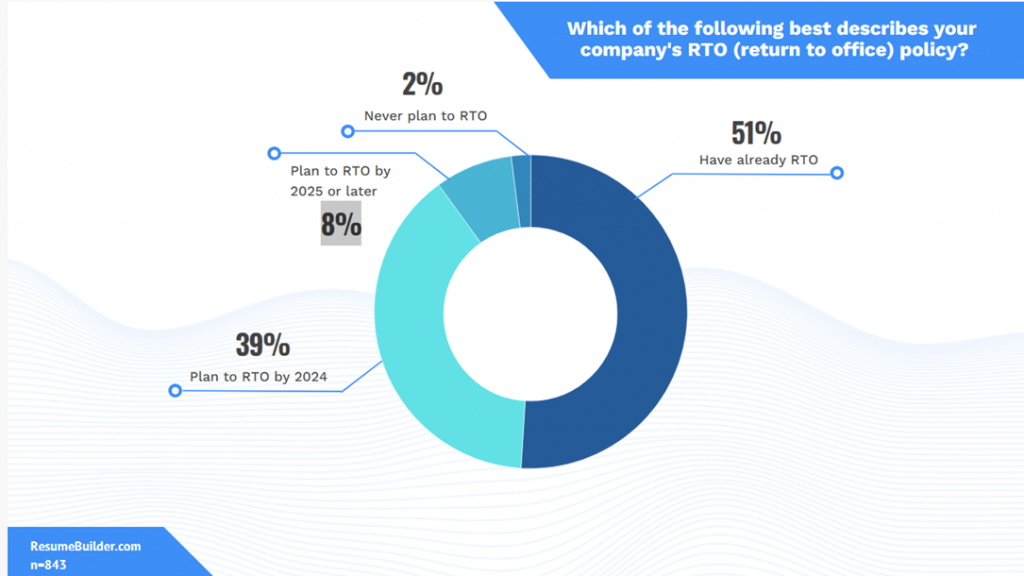Resume Builder’s recent survey signals a massive shift in workplace dynamics: by 2024, 90% of companies will have completed their return-to-office (RTO) transition. While many see the benefits of in-person collaboration, a significant segment of the workforce remains apprehensive. Employers face the challenge of balancing an imminent transition with the well-being of their workforce.

This blog analyzes the survey results, explores the push-pull dynamic of RTO and future work arrangements, addresses employee concerns surrounding RTO, and provides empathetic strategies for a smooth transition.
Pressed for time? Here’s a quick summary…
- RTO movement: The transition back to the office is primarily driven by the value of in-person collaboration. Among organizations that have started requiring in-office
- Push & pull: Many employees have grown accustomed to more flexible routines established during the pandemic era, while organizational leaders cling to traditional in-office norms—a classic case of “old habits die hard.” The rise of hybrid work models seeks to strike a balance.
- Ethical concerns: RTO brings ethical concerns, including job security threats and forceful measures to enforce compliance.
- Aligning RTO policies with employee well-being: Encourage and adapt to employee feedback and concerns regarding RTO policies. This involves tailoring policies to individual roles and well-being needs. Additionally, provide meaningful benefits that address common challenges, such as childcare benefits, flex-time, and mental health initiatives, which provide essential support for employees navigating this change..
- Supportive measures: Offering incentives such as commuter benefits, childcare benefits, and catered meals can address some common employee concerns regarding RTO. Upgrading the office with flexible spaces and tech-enabled workplaces can also ease the transition.
The Pulse Of Return & Employee Sentiments
The return-to-office (RTO) movement is in full swing, with 90% of companies set to complete their RTO by 2024. Among those that are already requiring in-office presence, three out of four organizations report advancements in revenue growth, while others note improvements in productivity and employee retention.

In-person collaboration remains a driving force of RTO. The potential to enhance creativity, innovation, and team dynamics, coupled with spontaneity of in-office interactions, is difficult to replicate in remote settings.
Employee sentiments regarding RTO are mixed:
- Optimistic employees highlight improved communication as a motivating factor.
- Apprehensive employees voice concerns related to commuting and maintaining work-life balance.
Recognizing these diverse sentiments, it’s crucial for organizations to approach RTO with empathy. While the benefits of in-person interactions are undeniable, it’s equally important to acknowledge and address the concerns of the entire workforce. A successful RTO strategy will consider both the organizational goals and individual employee needs, ensuring a harmonious and productive work environment.
Resisting Change: Old Habits Die Hard
Change is inherently challenging for humans, and the corporate world is no exception. In the case of remote work, which was initially viewed as a temporary measure, organizational leaders are eager to revert to the “old habits” of in-person work.
Some companies, like Goldman Sachs, are embracing the traditional convention of a five-day in-office workweek. Others, like Google, are intensifying their RTO efforts, incorporating office attendance into performance evaluations.

The continual tug-of-war unfolds between employees pushing for flexibility and organizational leaders pulling employees back to the office. A fully remote work model may not be the immediate future for most businesses, as evidenced by Resume Builder’s survey. However, clinging to a rigid five-day in-office workweek risks spurring resentment and losing trust among employees.
“I think the concept of spending five days a week in the office is dead. That top-down, one-size-fits-all approach can lead to a lot of resentment among workers.”
Brian Elliott, Executive Advisor on Flexibility and Founder of Future Forum
Ethical Concerns Surrounding RTO
Twenty-eight percent of companies will threaten job termination to enforce their RTO policies. The strong nature of such measures could create a work environment dominated by fear and insecurity.
“Companies can threaten to fire employees over RTO policy, but they should keep in mind that this is still a very strong candidate market in many industries. Companies who insist on RTO when employees are resistant may lose workers and struggle to hire talent from a smaller candidate pool.”
Stacie Haller, Chief Career Advisor of Resume Builder
Furthermore, a forceful approach to compliance could jeopardize employee well-being. The transition to in-person work must be handled with respect and sensitivity to individual preferences and concerns. Neglecting this aspect may have adverse effects on employees’ work-life balance or mental health.
“It’s important to note that, when it comes to RTO, one size does not fit all. The majority of business leaders who plan to RTO in 2024 seem to understand that, in order to retain talent, they can’t force unwilling employees back to the office.”
Stacie Haller, Chief Career Advisor of Resume Builder
7 Empathetic Strategies For A Smooth Transition
As employers continue to refine their RTO plans, they must balance organizational objectives with employee needs to ensure a seamless transition that upholds a commitment to well-being.
1. Two-Way Communication

Organizations must prioritize transparency by sharing the rationale behind the RTO plan and providing regular updates about the process. Welcoming feedback through open forums and frequent check-ins ensures employees feel like active participants in the process rather than reluctant subjects. Employers that adapt their strategies accordingly demonstrate authentic care for employees.
2. Leadership’s Pivotal Role
Effective leaders go beyond the logistics of returning to the office; they prioritize the emotional well-being of their teams. This involves recognizing and adapting to the challenges and concerns of each employee, cultivating a psychologically safe environment where team members have confidence in leadership to address their needs.
Leaders also set the tone for how the organization’s values align with the RTO plan. If a company emphasizes flexibility but enforces a rigid RTO plan without considering individual needs, it can raise questions about the organization’s integrity. Therefore, leadership must lead with empathy and adaptability, ensuring that the RTO process reflects a genuine commitment to both the professional and personal well-being of employees.
“For companies who said employees could work where they wanted to, how do you convince them that going back to the office is the right thing to do?”
Susan Vroman, Lecturer in Management at Bentley University
3. Embracing Flexibility

A one-size-fits-all approach rarely aligns with the diverse range of circumstances and job roles within an organization. Work arrangements should be as adaptable and varied as the people they serve.
Case Study:
Onur Kutlubay, founder of YouParcel, demonstrates the importance of flexibility with his partial RTO plan, targeting roles that benefit from on-site collaboration. This encompassed areas like product development and client interactions, which constituted 40% of the workforce.
Instead of imposing a uniform RTO model, YouParcel embraced adaptability, recognizing that not all employees require the same level of in-person presence. This resulted in a more employee-centric approach that maximized the benefits of in-person work where it mattered most.
4. Meaningful Benefits
Commuting, work-life imbalances, and financial strain are common concerns surrounding RTO. For many employees, commuting, office attire, and daily lunches can cost over $100 per week or up to $45 per day. In response to these burdens, employers are stepping up with enticing benefits:
- 72% of organizations will provide commuter benefits
- 57% will offer childcare benefits
- 64% will provide catered meals
These perks signify a commitment to addressing the practical and personal challenges employees may face when returning to the office.
5. Hybrid Work Arrangement
Of the organizations that plan to RTO in 2024, only 19% will require in-office presence five days per week. The remainder are implementing hybrid work models, which marry the strengths of remote and in-person setups. This arrangement emerges as a sustainable, long-term solution that strikes a balance between employee flexibility and in-person collaboration.

Within this arrangement, some employers are designating “anchor days” when everyone converges in the office and allowing employees to choose the rest of their preferred on-site days. This empowers employees with autonomy while reaping the benefits of social interaction and collectively tackling tasks on the anchor days.
6. Upgrading The Office
As organizations embrace the era of hybrid work, tech-enabled workspaces can bridge the gap between in-person and remote collaboration. This includes high-quality video conferencing platforms, task management tools, and instant messaging services. These foster connectivity and participation regardless of work location.
Additionally, one survey indicates that employees are more inclined to work in person if their office provides a blend of spaces that cater to their needs, such as quiet spaces and collaboration zones. These not only serve as enticing features that enhance employee experience, but they also promote inclusivity by accommodating the unique work requirements of those who thrive in a less distracting environment.
7. Mental Health Initiatives

The transition back to the office involves dealing with a range of stressors, from commuting anxieties and adapting to office routines to the balance between work and personal life. The potential health risks, particularly with the spread of new COVID variants, can compound these stressors, underscoring the need for mental health support and flexible accommodations in the workplace.
Employers can implement measures to support mental well-being such as:
- Conducting one-on-one mental health check-ins
- Partnerships with therapy and counseling services
- Organizing wellness activities like meditation and mindfulness exercises












